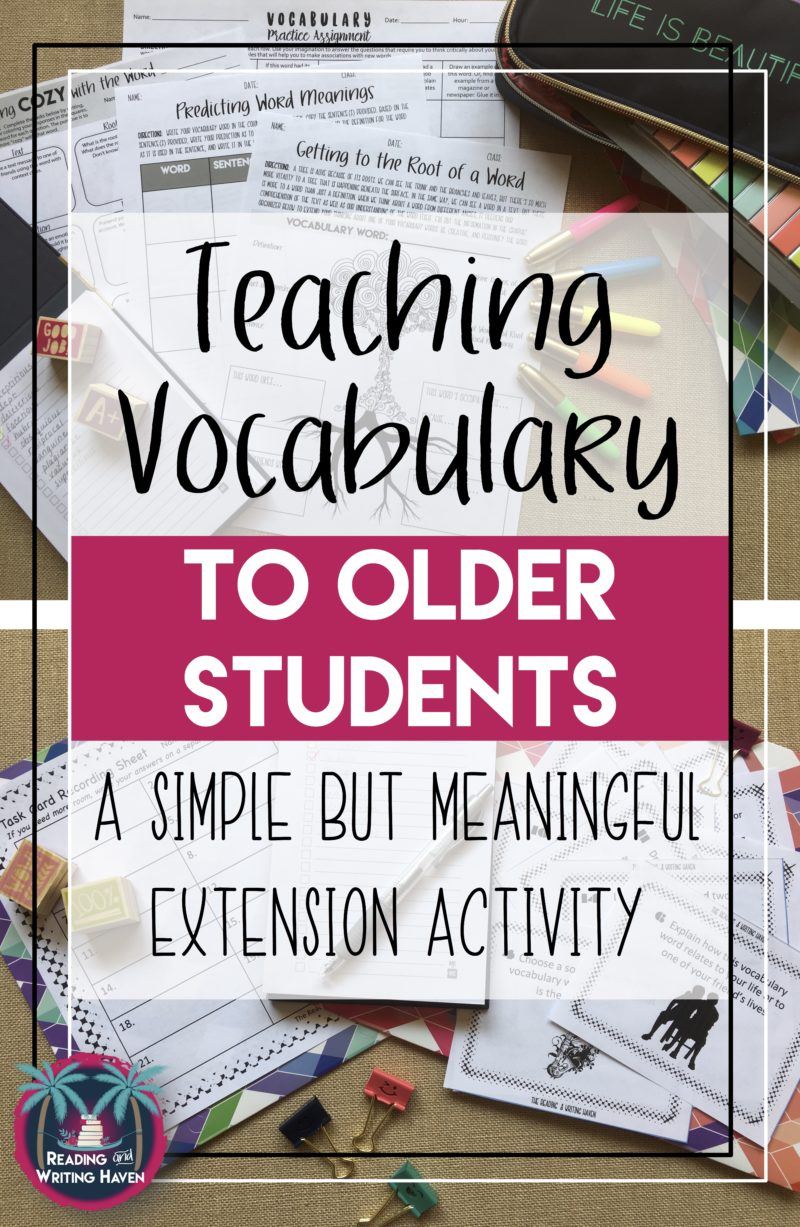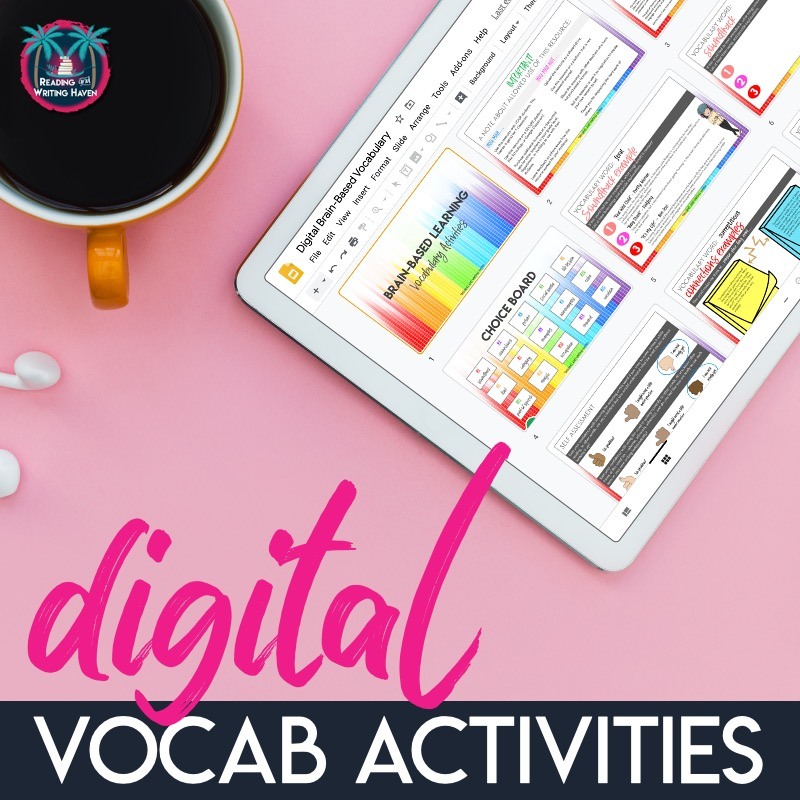A Fun Vocabulary Activity for Middle or High School
Teaching vocabulary in high school? It can be difficult but also rewarding. In this post, read about ideas for teaching vocabulary to older students. Included, details for a simple but meaningful fun vocabulary activity to extend learning.
TWO WAYS STUDENTS ACQUIRE NEW WORDS
Word knowledge directly impacts students’ reading comprehension. Vocabulary experts agree that in order to comprehend what they read, students need to know between 90 and 95 percent of the words they will confront in a text. If a student approaches a text with that level of readiness, he or she will be able to determine the main idea and make educated guesses about the meaning of unfamiliar words, which is how that student acquires new vocabulary indirectly.
For this reason, one of the best ways you can introduce your students to new words is by allowing them opportunities to learn vocabulary indirectly through reading experiences. Students can and should read on a daily basis – at all ages. Reading books at the appropriate reading level is the best vocabulary extension activity you can provide in any content area. Still, teachers need to introduce students to new words directly as well.
KEYS TO DIRECT VOCABULARY INSTRUCTION
What are the keys to effective direct vocabulary instruction? Pinpointing the answer to this question can lead to powerful transformations in the way you approach vocabulary in your classroom. According to research, several key factors play into ensuring that students learn the words instead of simply memorizing them.
1. Size
The list size needs to be small and manageable. Determining an appropriate number for your students might be a process of trial and error. It depends on your students’ age and ability, their existing background knowledge, and the sophistication of the words you are asking them to learn.
In my high school classroom, lists consist of ten to fifteen words, and I allow students two weeks to interact with them on a daily basis before I expect mastery. Less is more. Quality over quantity. When it comes to vocabulary lists, the cliches apply.
2. Presentation
Students need to hear and see the word used in meaningful and specific ways before we can expect them to do so on their own.
When I introduce words, I always do so via direct instruction, never by assigning a list and asking them to look up the definitions on their own. As I introduce the word, I engage students in meaningful discussions, whereby I can help them understand the word’s derivatives and connections to the real world.
Direct instruction is a perfect time to use mentor sentences and allow opportunities for teens to see the words used contextually in literature.
3. Practice
Students need to have ample opportunities to interact with the word every day. For this reason, I always make time for my students to study their words during class. You’ll know when students have actually learned the words. They’ll use them in their speaking and writing, and they will refer less to their notes during review. I always try to keep a fun vocabulary activity on hand to keep practice fresh.
Using brain-based vocabulary approaches will help to ensure the practice time you provide is worthwhile. When I complete a vocabulary unit, my students know we will continue coming back to those words throughout the year. This repetition reinforces the likelihood that students will retain the new words.
4. Engagement
Students need to be engaged when learning about new words. Teachers can accomplish this goal through choice and differentiation as well as by pulling in topics of interest. For instance, referring to current events, school controversies, and pop culture are just a few examples of how engaging students through associations will make learning more valuable and memorable. When teachers help students to truly love and appreciate learning new words, magic happens.
DIFFERENTIATING VOCABULARY
I have a passion for differentiating vocabulary instruction by learning styles and abilities. I’m always devising new ways for students to think about their words…different angles that might offer another perspective on how to use a word or remember it. In one of my favorite differentiated vocabulary assignments, I offer my students countless angles for approaching words on any list. Through creative questions, I prompt my students to analyze a word in unique ways. For instance…
Fun Vocabulary Activity 1
Think about the meaning of this word: abase. If you were to give this word a rating (think movie rating) for its appropriateness, what rating would you give it, and why?
This question would first require students to review the meaning. Abase means “to behave in a way so as to belittle or degrade someone. Then, students would need to think about that definition deeper. Does a word like abase deserve a G, PG, PG-13, or R rating, and why?
Obviously, there’s no one right answer. Students might respond that it should be rated PG-13 because parental guidance is advisable when children are being mean to others. They might further explain that bullying is common in high school, which is why they rated it a PG-13 instead of just PG. Asking students this one simple question has allowed them to make connections to real-life (bullying and the idea that parental guidance is necessary when one child is abasing another), which strengthens their connection to the word.
Fun Vocabulary Activity 2
Here’s another example:
Create an acrostic poem using the vocabulary word. Make sure the poem reflects an aspect of the word and illustrates how you think about it.
- A – afraid
- B – belittle
- A – antagonize
- S – shame
- E – esteem
Students might then provide a written explanation of their acrostic.
The vocabulary word abase has a negative connotation. When I think of this word, I’m reminded of people who are afraid of those who degrade others. Students who are abased might be scared to go to school for fear of being belittled. Bullies often antagonize people by shaming them. Sometimes they do this in person, but more, often, they do it on social media. When victims are abased, their self-esteem is impacted.
A SIMPLE VOCABULARY EXTENSION ACTIVITY
After my students interact with a vocabulary word through the task cards and supplemental exercises, it’s easy and effective to ask students to reflect on what they have learned with a fun vocabulary activity that encourages them to extend their learning.
Using the numerous answers they provided during the differentiated vocabulary practice, I ask them to select the associations they made that are the most powerful. I ask them, Which connections really help you to understand this word? Which connections helped you to have the “Ah ha! I get it!” moment? Using those responses, students create a mini poster. They can do this artistically by hand drawing, by making a collage, or by compiling ideas digitally.
Then, I use these posters to create a word wall. Each student will connect with vocabulary word differently, so the posters can be extremely unique. When they see their words displayed on the wall, it helps them to take ownership of their learning and feel proud they have contributed to their environment – win, win!
RELATED RESOURCE:
Looking for a fun vocabulary activity? They are my jam. Click on the image below to view the details of the differentiated vocabulary practice assignment that allows students to interact with their words from various angles in meaningful ways.
[sc name=”mailchimp1″]

